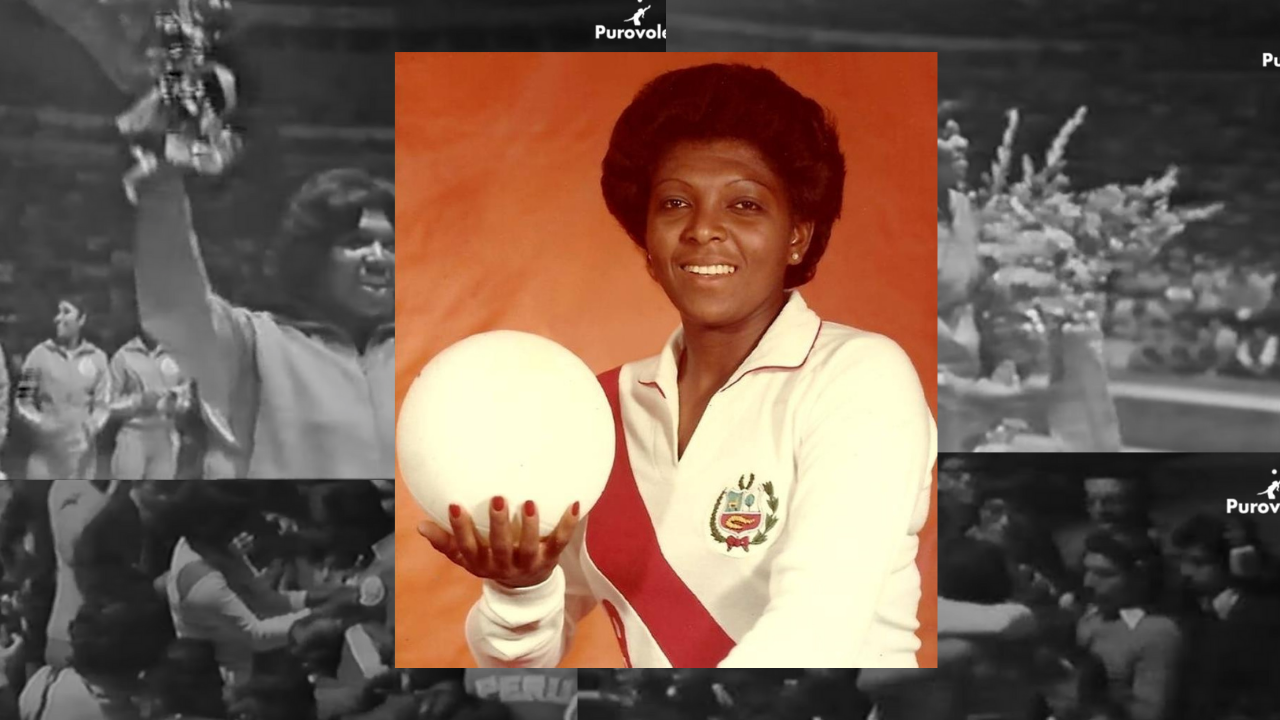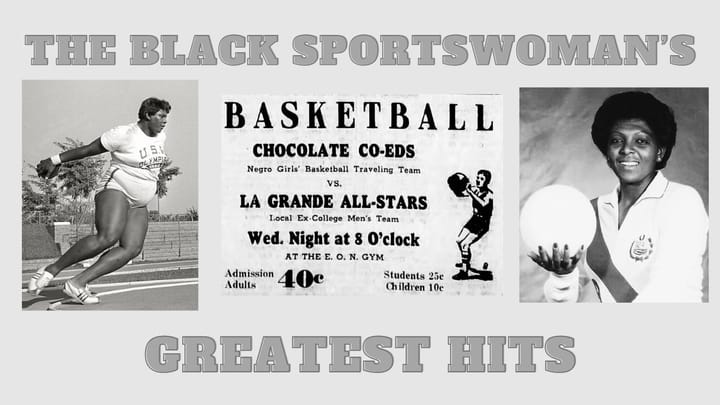The Black history of Peru women's volleyball
Black women have been at the forefront of the past, present and future of Peru women's volleyball.

Luisa “Lucha” Fuentes’ farewell match may be a reflection of her place in Peruvian history.
It’s 1979, and an international friendly volleyball match between Peru and Japan is about to begin.
Before the competition, the Amauta coliseum in Lima, Peru is packed with citizens prepared to bid farewell to a volleyball legend: an Afro-Peruvian woman, who, along with her coaches, led the national team to multiple South American championships and Pan American Games silver medals.
Fuentes’ facial expression seems shy as the crowd continues to cheer for her – almost overwhelmed by all the praise – before she removes her warmups for her standard white long sleeve uniform top – the red diagonal stripe across the front – and red bottoms.
This ceremony is a moment in history for Peru and Fuentes, captain of the team, who is honored with flowers, plaques, and standing ovations, while surrounded by reporters, cameras and microphones.
It was a spectacular sendoff.
“Fuentes will be eternally associated with the origins of competitive volleyball,” writes Abelardo Sánchez-León in The History of Peruvian Women’s Volleyball. The father of Peru women’s volleyball, Akira Kato, discovered the Ica native.
Years later, Fuentes would tell local news that people would come up to her and thank her for all that she did, and want to talk with and hug her.
“I like it because I feel that everything I did is not in vain,” she said in 2019.
But back during her last match, after her ceremonial first serve, Fuentes passed the captain badge over to another Black Peruvian woman, Ana Cecilia Carrillo. Cecilia Tait, possibly one of the most famous Peruvian volleyball players, also started that match.
Fuentes helped build the foundation for elite Peruvian women’s volleyball, a team that would go on and win the silver medal in volleyball at the 1988 Seoul Olympic Games – with Tait as captain.
Peru didn’t have an All-Black team, like Cuba, but as Sánchez-León says, “The principal Peruvian volleyball players are Black.”
With players like Fuentes, Tait, Carillo, Gina Torrealva and Leyla Chihuán and their consistent success, Black Peruvian women, through volleyball, served as symbols of pride, glory, and inspiration in their country. They represented the nation on the highest stage.
“When you think about Peruvian volleyball, it is very much associated with Black women and Black women playing volleyball is very much associated with national pride and pride of discipline and work ethic,” says Liliana Michelena, a Peru native and sports journalist. “We aspire to be like them, or we wish we were like them.”
How to support The Black Sportswoman
To understand the significance of Black women representing the country this way, and the glory they brought the nation, it’s important to explore the experiences of Black and afro-descendent women in Peru.
It started with the Transatlantic Slave Trade. The first Africans arrived in Peru during the 1500s; slavery was abolished in 1854. Similar to the rest of the world, white supremacy, racism, and classism developed. Though these topics have not been widely discussed in the same way in Latin America due to the concept of mestizaje, the idea that everyone is mixed and therefore equal. That concept ignores the Black and Indigenous populations as well as the racism they face.
“This apparently inclusive discourse conceals the reality of racism and racial inequalities in the country,” writes Sharún Gonzales Matute. “The effects of mestizaje as a political discourse included the statistical invisibility of people of African descent.”
Gonzales Matute’s thesis, titled “Race, Gender and Power: Afro-Peruvian women’s experiences as congress representatives,” discusses the inequalities Black Peruvian women face: racism, racial discrimation, domestic violence and lack of access to education and healthcare.
In a separate article, she notes that according to Peru’s INEI, 27.5 percent of the Afro-Peruvian population lives in poverty and less than the national average have access to higher education.
Volleyball has been considered a sport that anyone can play anywhere, though. Sánchez-León said the sport was “adopted by the working class,” and Michelena adds that it’s easy and convenient to play at parks or in fields.
Now, volleyball remains one of the most popular sports, right there behind men’s football, and the most popular for women to play.
It’s also been used as a “bridge” for upward mobility.
In 2013, Peru had three Afro-Peruvian congresswomen, all of them former volleyball players, according to Gonzales Matute. “Volleyball became the bridges, as it were, which would lead the Peruvian woman out of domestic labor. It was a form of modernity, a form of female success, independence,” Sánchez-León wrote.
Former middle blocker Pamela Barrera started playing volleyball at 12 years old after being introduced to the sport on a family vacation and has since traveled to Mexico, Venezuela, Cuba, Japan, and Spain for volleyball.
“I have an education because of volleyball. If it wasn’t because of volleyball, I couldn’t be able to, in my time, be able to enter college,” Barrera, “Like I said, (the federation) made us choose (between volleyball and school). My family didn’t have money to pay (for) university and at that time they didn’t give us scholarships in sports.”
Barrera began to research places where she could do both, and one of her options was the United States. She applied to scholarships with the help of her U.S. based family member and had been focused on community colleges when she heard from Florida A&M University volleyball coach Tony Trifonov.
He’d seen a video of her playing internationally and wanted her to apply to FAMU. He flew in to meet her family, and Susan Egoavil, also a Peruvian volleyball player though not Black, was already playing at the school.
The two ended up as roommates, and in 2010 six Peruvian players were on the team at FAMU. (Multiple Peruvian Rattlers are on the 50th anniversary MEAC All-Time Volleyball Team.)
“They saw us playing there and having an education there, that’s why all the other Peruvians applied to play for FAMU,” Barrera noted.
Barrera retired earlier this year, at 30, after an ACL tear in 2020 – which included Zoom rehab from home in Lima – and reinjuring her knee two weeks before a tournament she was set to play in.
Now, she is focused on coaching – her favorite parts of the game are the camaraderie and watching young players learn new skills.
Shiamara Almeida – setter of the national team – is a young star who competes for Alianza Lima Vóley and is sponsored by Gatorade. Almeida speaks about racism, her experiences as a Black woman, and ESPN ran a 10-minute feature on her in 2019.
The national team hasn’t qualified for the Olympics since the 2000 Games. In the country, there is the Liga Nacional Superior de Voleibol Feminino – of which Leyla Chihuán was the league MVP in 2009-10.
After Barrera left Peru, universities started giving scholarships to volleyball players, and there are still players competing professionally in Peru and abroad, but Barrera wants to see it become a sustainable profession for most.
“We need to have professional volleyball here, because it’s not professional. We have to have agremio (union) to have our rights taken care of,” she said. “Last year with the pandemic, people (weren’t playing), I know a lot of girls, they still didn’t get paid.”
Before, there was Fuentes, Tait, Chihuán and Carillo. Now, there’s Almeida, Clarivett Yllescas, Maguilaura “Magui” Frias, Ángela Leyva, and Jessenia Uceda.
Peru has a rich history of women’s volleyball, with Black women at the forefront of its past, present and future.



Comments ()